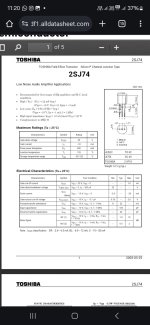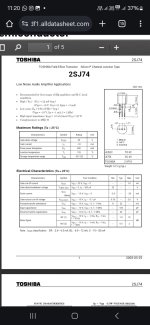Quick note of appreciation. Checked offset and bias nine months after completion of AJ. Completely stable no need for adjustment, offset near 0 and bias 400mV +/- small variance. Since case is a 4U/300 and I run 30V rails, it runs hot so doubt I will raise the bias without forethought.
Hi,Quick note of appreciation. Checked offset and bias nine months after completion of AJ. Completely stable no need for adjustment, offset near 0 and bias 400mV +/- small variance. Since case is a 4U/300 and I run 30V rails, it runs hot so doubt I will raise the bias without forethought.
Curious about your rail voltage of 30V. Are you running a "stock" Aleph-J board with 2SJ74's? I was wondering if this voltage might reduce the lifespan of the devices. About how many hours do you have on them with no failures? It's something I might try as a bit more power out would be good.
Thanks!
Just placed my order! Thanks!
Missed out in the VFET lottery, glad I got this one.
Hi,
Curious about your rail voltage of 30V. Are you running a "stock" Aleph-J board with 2SJ74's? I was wondering if this voltage might reduce the lifespan of the devices. About how many hours do you have on them with no failures? It's something I might try as a bit more power out would be good.
Thanks!
See here with regards to the 2SJ74’s and their capabilities.
With regards to the output transistors in the Aleph J, they can handle rail voltages of +/-30V and high current, i.e. 1.8-2A - the limiting factor is of course the heatsink. I stop at 55 degrees C on the heatsinks. If I want more bias, I get larger heatsinks or fan cool or water cool. You will get more power but not that much more…realize this is a single ended design and 4 ohm loads are challenging (i.e. you need even higher bias currents, like 3A, etc…). If you really need dramatically more power, switch to push pull for convenience or go for an Aleph 60, Aleph 2, etc…which have higher voltage rails, more devices, etc…while employing the SE topology.
With any Aleph J or variant I have built, I always erred on the side of caution and stuck with 400mm deep sinks from Modushop (and minimum 4U height as well).
The SuperCoolExtraNeatoChassis is a nice choice with character to boot!
Best,
Anand.
Last edited:
Excellent information. I first looked at building the AJ about 10 years ago and your post reminded me that I did see NP saying the 2SJ74's could handle higher voltages than 25V. All caps on my board and supply are 35V or better. Since I have a pair of transformers that are bigger (22VAC secondary) I could use those, and end up (with diode drops) at about 27V.
Can I ask what transformer secondaries you have, and what VA? Are you using one or two transformers? I have another question but I'll post it separately as it's not to anyone specific.
Can I ask what transformer secondaries you have, and what VA? Are you using one or two transformers? I have another question but I'll post it separately as it's not to anyone specific.
Roger,
I typically don’t use the usual flavor of CRC or CLC supplies, and also don’t use passive rectification with my amp builds. All my current amp builds use ‘active rectification’ and most use either ‘C’ supplies or capacitance multipliers (with a pre-existing CRC filter before the cap multiplier). I don’t have to think or consider ’snubbers‘ prior to or associated with the rectifier and the like.
My NPXP is what houses all of my Pass inspired builds. It’s currently going through a revision/rehaul but the essence of the build is the same.
Best,
Anand.
I typically don’t use the usual flavor of CRC or CLC supplies, and also don’t use passive rectification with my amp builds. All my current amp builds use ‘active rectification’ and most use either ‘C’ supplies or capacitance multipliers (with a pre-existing CRC filter before the cap multiplier). I don’t have to think or consider ’snubbers‘ prior to or associated with the rectifier and the like.
Can I ask what transformer secondaries you have, and what VA? Are you using one or two transformers? I have another question but I'll post it separately as it's not to anyone specific.
My NPXP is what houses all of my Pass inspired builds. It’s currently going through a revision/rehaul but the essence of the build is the same.
Best,
Anand.
Hi friends,
For my new project Aleph J, JFETs Q1A, Q1B - LSJ74 are the only option to be considered (found in digikey) other than 2SJ74 ( very difficult to get genuine one). But my concern in choosing LSJ is that having different varients like LSJ74A,B, C, D. Having various Idss values in electrical parameters. So which one to be selected.
Attached data sheet of both LSJ and 2SJ for reference.
One more thing in the case of BJTs Q2-PNP and Q3,Q4-NPN. For Q2 - ZTX551and Q3,Q4 - ZTX451 are my options (available on dijikey and mouser) even though having low (hfe upto=150) because ZTX550 are obsolute.
What are the better options for these BJTs (which are easily availabe on dijikey and mouser) without changing circuit component parameters in aleph j.
I am a beginner in this field and your suggestions are greatly appreciated.
Thanking you all.
For my new project Aleph J, JFETs Q1A, Q1B - LSJ74 are the only option to be considered (found in digikey) other than 2SJ74 ( very difficult to get genuine one). But my concern in choosing LSJ is that having different varients like LSJ74A,B, C, D. Having various Idss values in electrical parameters. So which one to be selected.
Attached data sheet of both LSJ and 2SJ for reference.
One more thing in the case of BJTs Q2-PNP and Q3,Q4-NPN. For Q2 - ZTX551and Q3,Q4 - ZTX451 are my options (available on dijikey and mouser) even though having low (hfe upto=150) because ZTX550 are obsolute.
What are the better options for these BJTs (which are easily availabe on dijikey and mouser) without changing circuit component parameters in aleph j.
I am a beginner in this field and your suggestions are greatly appreciated.
Thanking you all.
Attachments
https://diyaudiostore.com/collections/jfets/products/matched-jfets?variant=39335246987337
https://www.digikey.com.au/en/products/detail/central-semiconductor-corp/2N5551-TIN-LEAD/4806921
https://www.digikey.com.au/en/products/detail/diotec-semiconductor/2N5401/13164304
... but don't think that I did you a favour... you should read this whole thread.
https://www.digikey.com.au/en/products/detail/central-semiconductor-corp/2N5551-TIN-LEAD/4806921
https://www.digikey.com.au/en/products/detail/diotec-semiconductor/2N5401/13164304
... but don't think that I did you a favour... you should read this whole thread.
Another reliable source of matched 2sj74:
https://www.ebay.ca/itm/25291527769...d3AGrOA0YHf+K481y0Ki3b6snl|tkp:Bk9SR-SZ-JraYw
There are lots of choices for the BJT's and no need to stick to ZTX. The main thing to look for is E-line or TO-92 pin compatibility with base at the centre pin. BC547/557 for currently available at digikey and you can choose the Hfe grade you prefer.
https://www.ebay.ca/itm/25291527769...d3AGrOA0YHf+K481y0Ki3b6snl|tkp:Bk9SR-SZ-JraYw
There are lots of choices for the BJT's and no need to stick to ZTX. The main thing to look for is E-line or TO-92 pin compatibility with base at the centre pin. BC547/557 for currently available at digikey and you can choose the Hfe grade you prefer.
So its better to go for matched jfets, and for bjts choose any series with required parameters.
Thank you all.
Thank you all.
Yes, the jfets should be Idss matched (say , to 1mA per Papa's recommendation) If you just buy a few pieces from Digikey, even within the same IDSS grade, there is no guarantee they will meet the recommended matching tolerance. And the LSJ part isn't exactly cheap either so you probably don't want to buy a large batch just to match a couple of pairs...
Brings up a question. NP has stated that the 2SJ74 could be run to 30V without any ill to the devices. (I'm running mine in Aleph J at 28.5V, SFSG) Do you know what the LSJ74 might tolerate? Interesting the Linear datasheet says "IMPROVED SECOND SOURCE REPLACEMENT FOR 2SJ74". Know anyone that has run these higher than 25V D to S? And thanks for the link to the ebay seller, bought a couple quads!Yes, the jfets should be Idss matched (say , to 1mA per Papa's recommendation) If you just buy a few pieces from Digikey, even within the same IDSS grade, there is no guarantee they will meet the recommended matching tolerance. And the LSJ part isn't exactly cheap either so you probably don't want to buy a large batch just to match a couple of pairs...
Roger,
If you look at the datasheets for Toshiba 2SJ74 and the Linear Systems LSJ74, you’ll notice a lot of similarities. One in particular that I noticed was that the maximum power dissipation or Pd was about 400mW. This gives me some reassurance…still I would pop some heatsinks on them!
Best,
Anand.
If you look at the datasheets for Toshiba 2SJ74 and the Linear Systems LSJ74, you’ll notice a lot of similarities. One in particular that I noticed was that the maximum power dissipation or Pd was about 400mW. This gives me some reassurance…still I would pop some heatsinks on them!
Best,
Anand.
The 400mW is at 25 C.
Perhaps de-rate to 1/4 to 1/3 of 400mW to be on the safe side, and heat sink if pushing it.
Perhaps de-rate to 1/4 to 1/3 of 400mW to be on the safe side, and heat sink if pushing it.
That’s exactly right, even Pass recommends choosing a lower Idss version to minimize the dissipation, which was pushing 200mW in the F5 turbo versions. Inside an amp will be a different, i.e. warmer thermal environment.The 400mW is at 25 C.
Perhaps de-rate to 1/4 to 1/3 of 400mW to be on the safe side, and heat sink if pushing it.
I personally would try it, but with heatsinks. If that’s too hot, then cascoding of course.
Best,
Anand.
- Home
- Amplifiers
- Pass Labs
- Aleph J illustrated build guide

